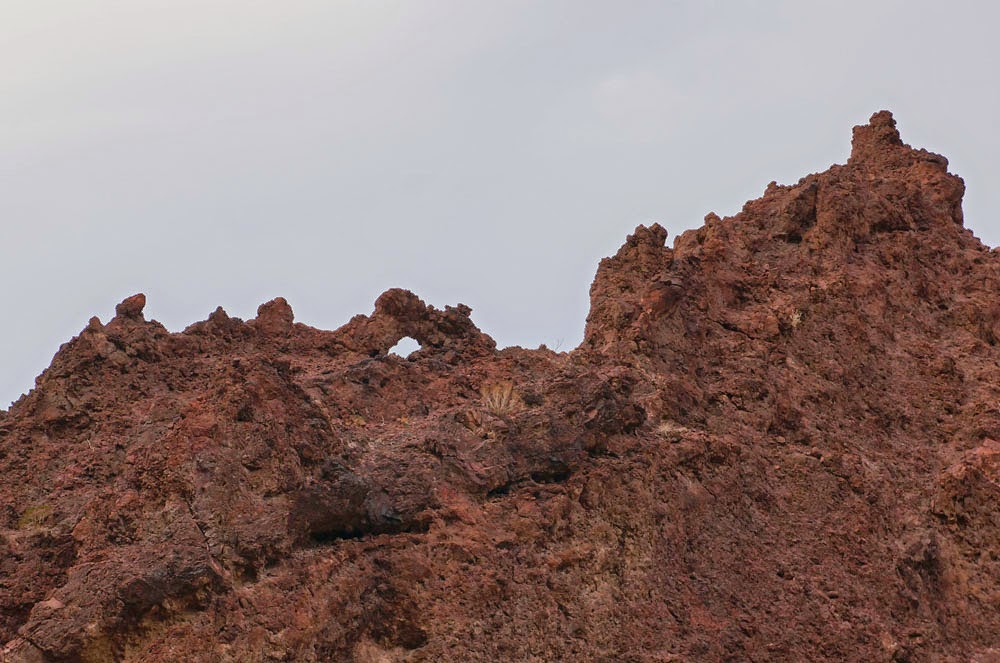
Sometime after the morning of creation, some adventurous white
rocks rumbled down from newly risen Wilson Ridge. You remember the Ridge from my mentioning it on
October 4, because you pay close attention to all passing comments in all the
blogs and posts you read. I remembered
my distant view of Wilson Ridge after reading that the strange white rocks I
saw today came from there. They traveled
some thirty miles and probably did it rather quickly, tumbling down a desert
gorge. They made a few lazy turns with
each 100-year storm, and maybe traveled a mile in each 1,000-year gully-washer.
Isn’t it great to be jolted into remembrance
from so long ago by something that happens today? But first, an introduction.
I drove in morning darkness to Boulder Dam, crossed the
Colorado River on the new bridge built in 2010.
Entering Arizona, and driving south on Highway 93 to the Arizona Hot
Springs trailhead, I arrived with sun’s first glow. And a glorious sunrise it was.
Calling it a trailhead implies there is a trail. But I soon learned that it’s just the way a
few people and wild burros have traveled.
I headed down White Rock Wash which would join the Colorado River. This is low elevation desert below Boulder Dam,
so vegetation is sparse and in the summer it can get very hot. Today, in the low nineties and partly shaded
within the canyon, it was pleasant.
And there I saw them—the bright white rocks, so out-of-place with
dark volcanic rock all around. Strangers
in a foreign land, they are no longer sharply broken as when they fell from
Wilson ridge so long ago, but rounded from miles of tumbling and thumping with
the push and splash of turbulent water.
Along the canyon wall, a conglomerate having many kinds of
little rocks, cemented into the larger rock wall, and polished smooth by flowing
water, like a terrazzo floor. The little
rocks are river stones from an older stream.


And I saw conglomerate rocks in the making, along the banks of
White Rock Wash. The cementing material,
still soft enough to chip away with my walking stick, but in just a few
thousand years, this might be another terrazzo floor. Notice the little piece of desert above the
conglomerate, the way a desert often looks when we don’t see underneith it.
Further down the Canyon, the rocks are reddish brown. They look somewhat like conglomerates, but show
signs of another kind of flow. Molten
lava rushed along here once, a pyroclastic
flow, where many rocks and boulders were caught up in a matrix of hot, fast
moving death, the kind that destroyed Pompeii in 79 AD.
An enormous boulder that fell from the high cliffs above; it’s
enough to make you stop and think for a minute.
The canyon deepens as I approach the Colorado River, with a
fringe of jagged volcanic ramparts looking down.
And then around a bend in White Rock Wash, the great river of
the west—the Colorado—with its guardian hound, collecting tolls, as on the
Rhine.

I walked a rocky “use trail” downstream along its bank, looking
for another gulch that should enter the river on my side. (A use trail is just where people and animals
have traveled. It often splits, leaving
a quandary as to which way to go.) I
scrambled along the steep banks of the Colorado looking for an entering
watercourse which should be Hot Spring Canyon.
I came to a gulch with a small flow of water entering the
Colorado. On testing its temperature
with my hand, I knew it flowed from a hot spring.


Turning into the canyon, I climbed up a few little waterfalls,
as the water kept getting hotter. In the
narrow windless canyon, it was like walking in a sauna.

And then a deep clear pool of hot water, reminder of the
earth’s hot interior that formed the pyroclastic flow. A world still hot and waiting for the signal
to strike again.

From here I had two choices for getting back to the car. I could go back the way I came. Or I could use the map, which indicated a
fair overland route continuing up Hot Spring Canyon, then over a ridge and back
into White Rock Wash near the trailhead. I always hesitate going back via an unproven
route, but this one seemed doable, and I had enough daylight to retreat if
necessary. I suppose if some major
problem has arisen, I would have told you.
Who knows?
 |
| Keith Brantley |

I returned in time to shower before driving to Keith Brantley’s
monthly Poet’s Corner at West Las Vegas Arts Center to read a few things about wilderness
walks and to ask if anyone knows where Mt. Charleston is. One person did, but she had not been there.
You can enlarge any picture.
Just click on it. Then click the “back”
button to return to where you were.























































